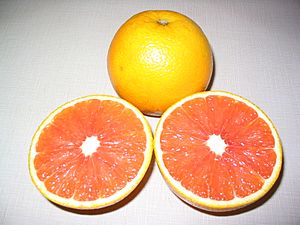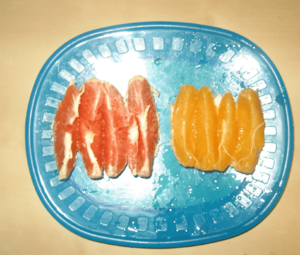Cara cara navel facts for kids
Quick facts for kids Cara cara navel orange |
|
|---|---|
 |
|
| Species | Citrus × sinensis |
| Cultivar | 'Cara Cara' |
| Marketing names | Power Orange |
| Origin | Hacienda de Cara Cara |
The Cara cara navel orange is a special type of orange. It's also known as the red-fleshed navel orange because of its unique pinkish-red inside. Scientists believe it first appeared as a natural change on a regular Washington navel orange tree.
Contents
How Were Cara Cara Oranges Discovered?
The Cara cara orange was first found in 1976. It was discovered at a farm called Hacienda Caracara in Valencia, Venezuela. It's considered a "botanical sport." This means it grew unexpectedly from a branch of an existing Washington navel orange tree.
The exact "parents" of this orange are a bit of a mystery. We only know it came from a Washington navel tree. Cara cara oranges didn't become widely available in stores until the late 1980s. For many years, you could only find them in special food markets.
What Makes Cara Cara Oranges Special?
These oranges are medium-sized. They are usually seedless, which makes them easy to eat. Cara caras are known for being very sweet and having a low amount of acid. This gives them a mild, pleasant taste.
They also have very little white pith. The rind, or peel, separates easily from the fruit. This makes them simple to peel and enjoy.
Why Are Cara Cara Oranges Red?
The inside of a Cara cara orange is a beautiful pink or reddish color. This color comes from natural substances called carotenoids. One important carotenoid in Cara caras is lycopene. Lycopene is also found in tomatoes and watermelons.
This is different from "blood oranges." Blood oranges get their deep red color from different substances called anthocyanins. So, while both are red, the reason for their color is different!
When Can You Find Cara Cara Oranges?
Cara cara oranges are available at different times of the year. This depends on where they are grown.
Oranges from South America are usually ready for sale starting in August. Fruits from Venezuela arrive in October. Cara cara oranges grown in California start appearing in stores in late November. You can usually find them all the way through April.


